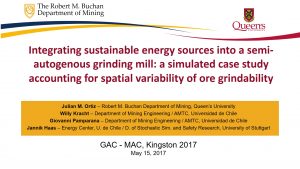
This work was presented in May, 2017, at the GAC-MAC conference held in Kingston, ON. The work was done in collaboration with Dr. Willy Kracht and Mr. Giovanni Pamparana, from Universidad de Chile, and Mr. Jannik Haas from University of Stuttgart.
See presentation here
[su_divider]
Integrating sustainable energy sources into a semi-autogenous grinding mill: a simulated case study accounting for spatial variability of ore grindability
Julian M. Ortiz (Robert M. Buchan Department of Mining, Queen’s University),
Willy Kracht (Department of Mining Engineering / AMTC, Universidad de Chile), Giovanni Pamparana (Department of Mining Engineering / AMTC, Universidad de Chile), Jannik Haas (Energy Center, U. de Chile / D. of Stochastic Sim. and Safety Research, University of Stuttgart)
Mining activity faces an increase in energy consumption, which is related to the lower ore grades, the increase in rock hardness and deeper mines. In order to make mining more sustainable, the integration of renewable energies is desirable. This work explores, through simulation, the integration of a solar photovoltaic system (PV) and a battery energy storage system (BESS) –as a buffer for the variations in energy (solar) production and consumption-, with grid backup, to operate a semi-autogenous grinding mill (SAG). We explore the effect of the spatial variability of the ore grindability, specifically, the SAG Power Index (SPI), on the energy required by the system to operate a SAG in a medium size mine. The spatial distribution of geometallurgical units defined in terms of grindability is simulated with geostatistical methods, as well as the distribution of SPI within these units. The spatial distribution is then converted into a time series that represents the truckloads of ore that are sent to the processing plant. This time series is translated into energy requirements of the SAG mill, and feeds a technical-economical optimization model that decides the operational balance between renewable energy and energy from the grid. The aim is to minimize energy imports from the grid and smoothening the power consumption (the ore hardness variability could result in exceeding the contracted power); thus, reducing the total cost of the energy consumed, and adding sustainability to the operation. The results show that the size of the PV-BESS system depends on the spatial variability of the rock hardness, and that having more than one stockpile may be beneficial for the SAG-PV-BESS system. This suggests that the integration of renewable energies into mining may need adapting the operation to new requirements. The geometallurgical modeling appears as a key tool to optimize the design of this integration.
Keywords:
Geometallurgy, Stochastic Simulation, Geostatistics, Sag Power Index, Solar Energy, Battery Storage
